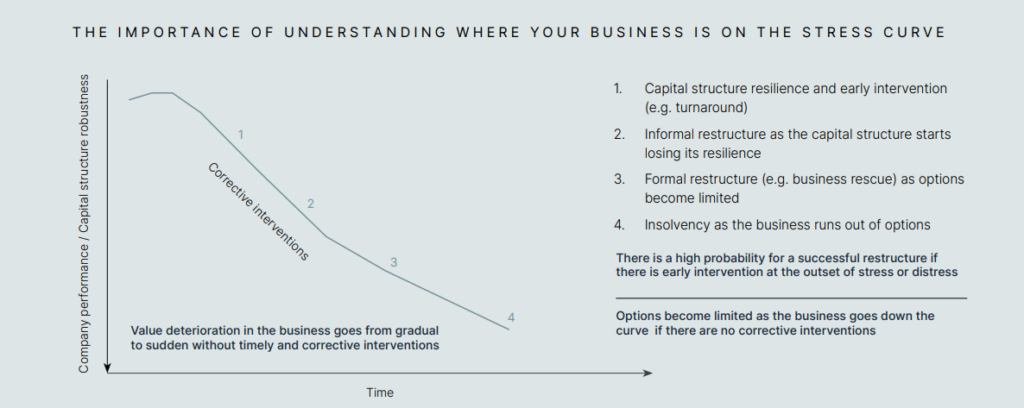- Home
- News & Insights
- Why early intervention is crucial when faced with business stress
Why early intervention is crucial when faced with business stress
Editor: Patrick Lawlor
Too many businesses fail to heed the early signs of business stress and find themselves faced with drastic choices. A capital restructure, if implemented early, can help avoid these drastic outcomes.
Ernest Hemingway wasn’t just one of the 20th century’s great authors, but he was also an astute observer of business finance. In his novel ‘The Sun Also Rises’, a character called Mike is asked how he went bankrupt. “Gradually and then suddenly,” he answers.
These four words sum up the problem for many businesses going through stressful times. Problems don’t just build up gradually, but they reach a tipping point where disaster becomes both inevitable and sudden.
Mike speaks with a knowledge gained after the event, when it is too late to intervene and prevent the trauma of insolvency. However, we can all benefit from his wisdom by recognising the early signs. This is especially relevant in the current economic environment in South Africa, where businesses and their customers grapple with failing infrastructure, loadshedding, high interest rates and weak consumer and business confidence.
Many South African businesses are dealing with these very issues right now. Sadly, many will move from “gradual” to “sudden” if they aren’t proactive in recognising and acting swiftly on the information they have. Once a company gets to a point where directors start to worry about going concern or reckless trading, it’s often too late to avoid the more drastic outcomes of business rescue or liquidation. This then leads to the loss of jobs, disruption to supply chains and reputational damage for management and investors.
It’s a far better approach for a business to look to restructure when the early signs of business stress appear.
While an early restructure can be a painful process for management, it’s often the best option for preserving the business and supporting stakeholders (investors, lenders, core shareholders, employees, suppliers, and customers).
An optimal, resilient capital structure helps to provide the funding flexibility that a business needs to navigate uncertain times and to deliver growth. Executive management can then focus on strategy and operations. Ultimately, all stakeholders will benefit from a business that is on a firmer footing and able to meet its longer term obligations.
Understanding the stress curve

It’s important to know where you sit on the stress curve – time may not be on your side when stress or distress becomes evident.
If the executive view and reality are not aligned a mismatch will soon lead to hard decisions, with very narrow alternatives.
Businesses will differ by sector or size, but we can highlight some of the common signs of stress:
· Worsening financial performance (sales declines, narrower margins, etc.)
· Liquidity pressure (cash flow deterioration, higher interest burden)
· Debt covenant breaches or pressure on covenants
· Stretching of creditors, late payment of debt
· Creditors and suppliers take action or require more demanding terms (e.g. early payment)
· Worsening morale, leading to higher staff turnover, fall in service levels, etc.
· Deteriorating share price
· Going concern issues emerge
· Delay in financial statement sign off
If the company is not in financial stress, there may nevertheless be concerns about its ability to deliver on its strategic goals with its current capital structure. There may also be vulnerability concerns that the capital structure is not resilient enough to support unexpected economic events.
All of these should be triggers for a business to act, to prevent further movement down the curve and leading to the point where “gradual” turns to “sudden”. As a business moves down the curve, so do the options become more limited and the likelihood grows that creditors and lenders take action to protect their interests, taking control away from management and increasing the likelihood of more drastic action.
Management and other key stakeholders have a key role to play in identifying these stress factors at an early stage. Non-executive directors, for example, are in a unique position to discern the signal from the noise, and ask difficult questions of executive management about the real status of the business and where it is on the stress curve.
Turning to the second part of the question, the good news is that an efficient restructure – if done early enough in the process – can limit the damage and even help position the business better to navigate its future.
Call in the specialists
If executive bandwidth and restructure expertise is limited, it makes sense to bring in an advisor to navigate the issues of an optimal capital structure. This allows the executives and the board to make informed decisions on the options presented, rather than face more drastic choices.
It’s important also to seek the help of a restructure advisory specialists as soon as the early signs of stress appear. A specialist is able to look at your business’s capital structure in a dispassionate, objective way, while also being able to draw on the experience of working with businesses that have gone through a similar process.
In addition, engaging a specialist also allows management to focus on the day-to-day running of the business and engaging with customers and suppliers, rather than having to deal with the complexity of a restructure on their own.
As a concluding remark, it’s worth noting that Hemingway’s character Mike, even as he grapples with bankruptcy, at least has the luxury of an inheritance to look forward to. This is seldom a luxury a troubled business can rely on – which is why it’s important to heed the early warning signs and bring in the specialists, before gradual becomes sudden.